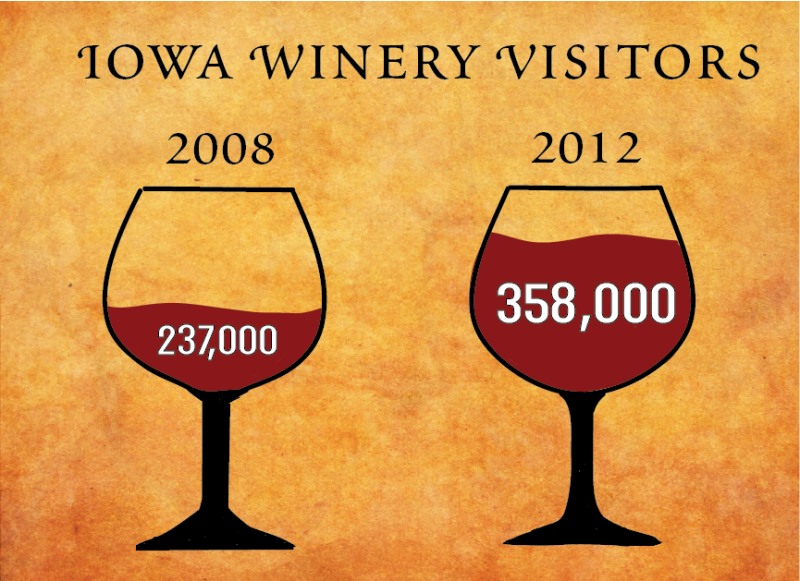Iowa wine industry on road to become regional leader
By Robert Mercer, [email protected]
This graphic compares the number of people that visited Iowa wineries in 2008 and 2012.
April 29, 2014
The state of Iowa may be on the verge of becoming a regional economic leader in the wine industry, according to a recent study from Frank, Rimerman + Co., a California-based consulting and accounting firm.
Looking at the United States as a whole, the consumption of wine has increased. Therefore, the demand for production has risen as well.
In 2012, about 752,431,183 gallons of wine was produced in the United States. In Iowa alone, about 373,436 gallons were produced that year, with half of the sales being local or through retail outlets such as Hy-Vee or Fareway.
According to the study, the economic impact of Iowa’s wine and grape industry jumped 80 percent from $234 million in 2008 to $420 million in 2012.
Dr. Murli Dharmadhikari, director of the Midwest Grape and Wine Industry Institute at Iowa State and adjunct associate professor of food science and human nutrition, researches the economical impacts in the wine industry in Iowa.
“The Midwest Grape and Wine Industry Institute was established in 2006 in the ISU College of Agriculture,” Dharmadhikari said. “Through this partnership, we are able to set goals for research, educational opportunities and activities.”
Dharmadhikari said Iowa had about 30 wineries a decade ago. Currently, there are roughly 100 wineries in 86 of the 99 counties in Iowa.
“Statistics show that the demand and supply have increased,” Dharmadhikari said. “Iowa still has potential to grow and could possibly be a leader in production in the wine industry.”
Since the production of wine has increased dramatically, jobs have opened up in the state. According to the study, 2,678 jobs are related to the wine industry.
The industry continues to expand with tourism, as well.
The report also said that roughly 358,000 tourists visited Iowa wineries in 2012, bringing in about $41 million last year. The number of tourists jumped about 51 percent from 2008.
Emily Saveraid, the marketing director of Iowa Wine Growers Association, helps with the research functions, events and, ultimately, helps the industry make better wine.
“The wine industry is closely tied with agriculture,” Saveraid said. “The quality of soil, amount of sunlight and water really affects the production of wine.”
Depending on the wineries’ locations, different grapes are used so they can thrive. Different grapes are grown in Iowa than California. The grapes produced in Iowa are more resistant to colder temperatures, and, therefore, Iowa and California wines have a distinct taste difference due to the types of grapes used.
“The types of grapes used is purely based on [demographics],” Saveraid said. “Also, companies have different techniques on how to grow and produce wine.”
Saveraid explains that the tourism industry has expanded due to the multiple additions of wineries across Iowa and the country.
They are more commonly located in rural areas where other attractions such as breweries, malls and hotels, are.
“In 2012, about $41 million was spent on wine tourists in Iowa,” Saveraid said. “More and more people are wanting to come to Iowa and learn about wine.”
Wineries across Iowa are willing to accommodate and hold different types of events to draw in tourists such as weekend getaways, business meetings, musical festivals or even weddings.
The rate of production of wine has multiple benefits, such as agriculture, tourism and a new angle.
“People like knowing where their products come from,” Saveraid said. “Because most of Iowa uses their own grapes, knowing their wine is produced locally gives the consumers a personal connection.”
Saveraid hopes in the future that people won’t be as intimidated by wine because of their fancy name or origin and become more comfortable.
Like Saveraid said, “As long as you like it, it’s good!”

















